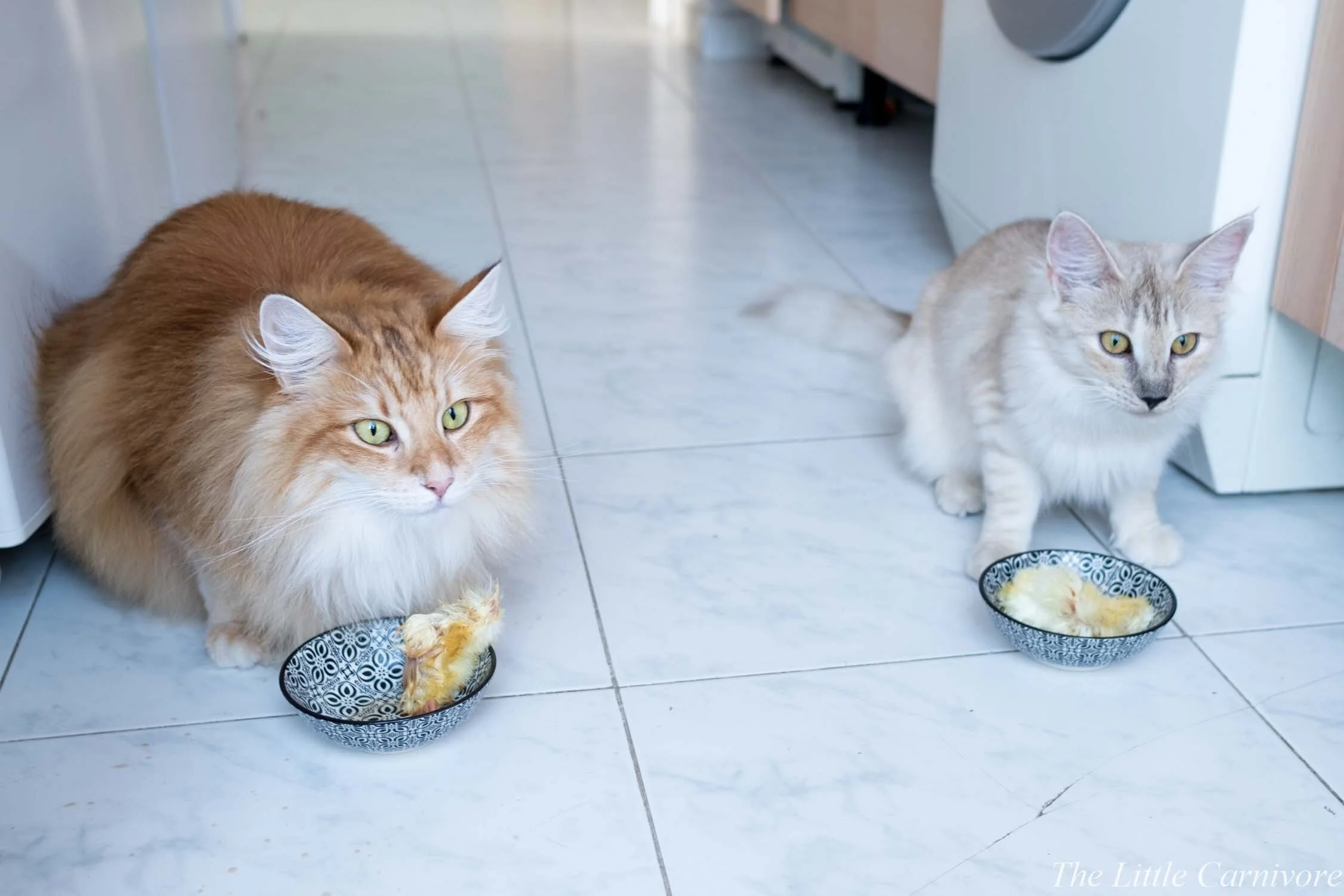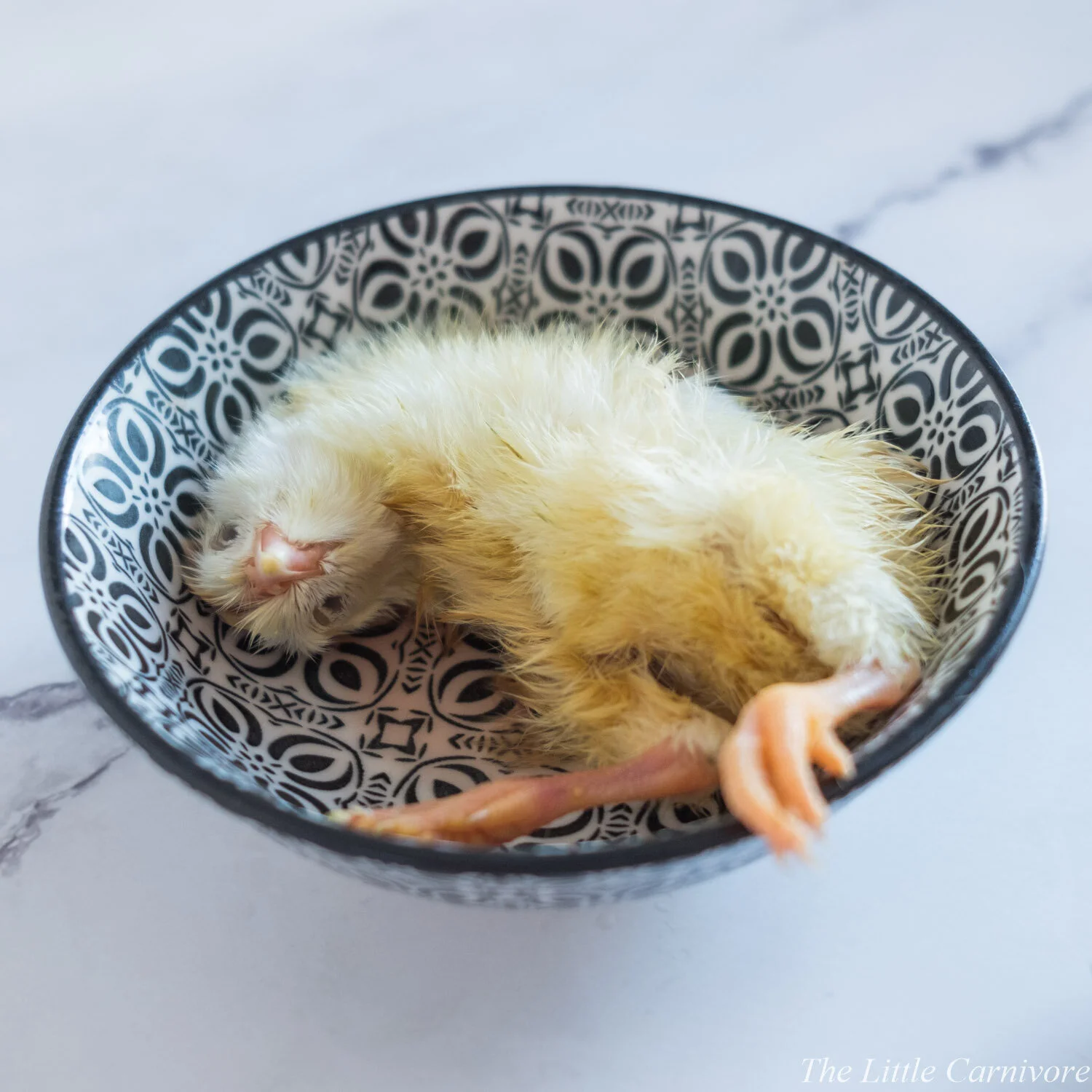What is whole prey feeding?
You may have heard of feeding “whole prey” and you don’t know what it is or how to do it? In this article, I will explain what this way of raw feeding is, and my advice on this type of diet.
Like the name says, "whole prey" consists of feeding entire prey animals a hunting cat would eat. Some examples of prey are chicks, rats, mice…
Feeding whole prey can be an occasional addition to a raw diet such as a prey model diet, or it can be an entire diet consisting almost only of whole prey.
Note: It is important to note that feeding whole prey doesn’t mean feeding alive prey! The prey is fed already dead and previously humanely dispatched. As cats often play with their prey before killing them, feeding them living prey would be animal cruelty.
The benefits of feeding entire preys
Feeding whole prey has many benefits. In fact, you give your cats food which is as close as possible to what they would eat naturally. As you may know, in a prey model diet (one of the most popular ways to balance a raw diet) the goal is to nutritionally recreate prey: therefore, feeding directly whole prey is in theory the optimal diet.In an entire prey, all the parts of the animal which are usually discarded for human consumption are present: organs, blood, the intestinal tract, glands, and of course the fur and feathers. All these are elements that a wild cat would eat but that are missing when we try to recreate whole prey from food available for human consumption.
It is also mentally stimulating for your cat, in the same way as feeding pieces of meat instead of ground meat. In fact, your cat needs to think about how it will approach and eat the prey: it will experiment with new and different textures, as the preys have feathers or fur. This can be really seen when you feed a whole prey to a cat for the first time: they will often play with it before eating!
Fur and feathers also provide insoluble fiber to the diet of your cats, which can be missing in a prey model diet.
Néline and Praline having chicks for dinner
The limits of feeding entire prey
Like in the case of the prey model diet, which has some limits and needs to be supplemented, the whole prey diet is only perfect in its “idea”. Feeding whole prey would be perfect if the prey we feed were identical and as diverse as the wild ones, and if the diet of a wild cat would be the ideal one for a domestic cat.
However, the animals you feed as prey are often farmed in conditions that are very different from wild animals. For example, industrially-raised animals don’t have the same level of activity as wild ones, nor the same food. All this changes their nutritional profile, like for free-range chickens that don’t have the same nutritional profile as caged chickens. Additionally, it would be very difficult in most cases to provide as much variety of prey as what a wild cat would hunt!
The second hypothesis is that the diet of wild cats is perfect for a domestic cat. However, wild animals most of the time have a shorter lifespan than our domestic animals, which can be due to malnutrition.
For these reasons, like for the prey model diet, supplements might be needed to complement a whole prey diet.
Feeding whole prey
The prey you can feed
The most important thing when choosing the type of prey to feed is to make sure it is adapted in size for your cat. For example, a mouse is adapted to a cat while a chicken would be too big.Here is a non-exhaustive list of prey you can feed.
Mice
Rats (some cats don’t like the strong taste of rats)
Quails
Small pigeons
Day-old chicks and very young chicken
Guinea pigs
Young rabbits
If you need to cut prey because it’s bigger than the daily ration of your cat, I strongly advise you to do it while it’s still frozen!
Mice and egg from @the_primalpack
As a part of a raw diet
If you feed a prey model diet or a PMR+ diet, a prey would count as meat, organs, and bones. You would then need to deduct the weight of the prey from the total weight you normally feed. You should, therefore, calculate the ratio of meat, organs, raw meaty bones on this total weight minus the weight of the prey.
However, if you feed young prey such as day-old chicks or young mice, their bones are not as calcified as the ones in adult prey because they are not entirely formed. The bones of young prey won't then provide as much calcium as the ones of adult prey.
I personally feed day-old chicks every other day, and on these days I generally feed smaller raw meaty bones.
If you balance your diet using the NRC nutritional requirements, it may be difficult to find the nutritional values of the prey as they are not in the standard databases which are made for human nutrition. In this case, I would recommend the Facebook group Raw Fed and Nerdy in which you will be able to find nutritional analysis for some whole prey.
As the entire diet
Feeding only whole prey can be an easy alternative to a prey model diet, as you don’t have to worry about calculating the amount of bones or organs in the diet as they are already in the prey. However, for the diet to be balanced you will need to provide a wide variety of prey such as mice, rats, chicks, quails, small rabbits… To improve diversity in the diet, it can also be interesting to vary the age of the prey.
As I said above, whole prey is not perfect and needs to be supplemented like in a prey model diet.
I would recommend adding 10% of oily fish to the diet in order to provide the necessary omega-3 and vitamin D, and supplements similar to the one I use in the PMR+ diet of Néline and Praline.
Sourcing the prey
Whole prey is one of the only things in a raw diet that you generally don’t find in a supermarket as it’s not for human consumption. You can generally find it in pet shops that sell food for reptiles or in online shops specialized in raw feeding.
In function of where you source it, prey can either be really cheap or really expensive. In my case, day-old chicks are very affordable at around 2€/kg (~2.2 USD/35 oz), while mice are very expensive at 21€/kg (~23.73 USD/35 oz).
Finally, the most advanced raw feeders which have the means to do so, breed the prey themselves (e.g. mice or quails) to then feed their pets.
Frozen chicks from an online order
Picky cats
Some cats may initially not recognize prey as their food, as they have never eaten anything with feather or fur. In this case, you can try to “open” the prey so that the cat can smell it and realize that it is indeed food. Cats also have a preference for warm food: if your cat is picky, you can try to warm the prey up by putting it into a plastic bag and then in lukewarm water. If it still doesn’t work don’t hesitate to sprinkle treats or something that your cat likes on top of it.
Finally, you can also try to make your cat play with the prey, to “awake” its instinct, and make it eat.
Excited cats
Some cats can get very excited when being served whole prey: they will often play with it before eating it. This is what happened in my case with both Néline and Praline. They played with the day-old chicks before eating by poking it, grabbing it and throwing it in the air. Praline sometimes played with it for up to 10 minutes before eating it! So, if you plan to feed whole prey, you need to prepare yourself for this possibility and to carefully clean everything up afterward!
However, after a while, this behavior stopped and now they both eat their prey directly, maybe because they got bored of it? Nevertheless, it remains one of their favorite food.
Day-old chick
Human Sensitivity
I know it can be difficult to feed whole prey, and you should know that it’s not something mandatory in a raw diet. So, if you are not comfortable with it, just don’t do it!
I myself wasn’t very comfortable with feeding chicks or mice at the beginning. However, after seeing how much my cats enjoyed it, I progressively became more comfortable with it.
To resume, feeding whole prey is a great way to enrich the life of your cat. However, feeding whole prey only shouldn’t be considered as a “perfect” diet.



